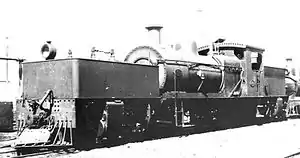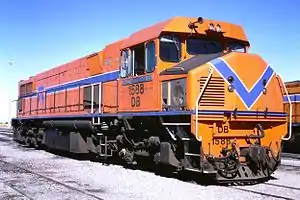| WAGR E class | |||||||||||||||||||||||||||
|---|---|---|---|---|---|---|---|---|---|---|---|---|---|---|---|---|---|---|---|---|---|---|---|---|---|---|---|
 E2 at Geraldton, 1886 | |||||||||||||||||||||||||||
| |||||||||||||||||||||||||||
| |||||||||||||||||||||||||||
| |||||||||||||||||||||||||||
| |||||||||||||||||||||||||||
The WAGR E class was a two-member class of 2-4-4-2T double-Fairlie locomotives operated by the Western Australian Government Railways (WAGR) between 1881 and 1892.
History
The E class engines were built by Avonside Engine Co, Bristol in 1879 for the WAGR's Northampton railway line, the first government railway in Western Australia, which opened that year.
In line with Avonside's practice for assigning build numbers to Fairlie locomotives, each end received a separate serial number. However, after a collapse in the price of lead, the heavy mineral traffic for which they were purchased dried up and they were placed in store. One entered service in 1881, with the second remaining in store until 1885 when a M class had to be withdrawn for overhaul.[1][2] When engine class designations were introduced in 1885 and became the E class, numbered E20 and E7.
In 1888, both were transferred to Fremantle Railway Workshops for use on the Eastern Railway. In 1891, E20 was cut up with the parts from one half with adapted to drive machinery at the Fremantle Railway Workshops, the other half was converted into a 2-4-2T tank engine as F20 in February 1893 for use at Fremantle Long Jetty. It was sold in February 1899 to Jarrah Timber & Wood Paving, Worsley and withdrawn by March 1905.[3]
E7 was withdrawn in 1895 and sold to the Canning Jarrah Timber Company for use on the Upper Darling Range Railway.[4] It was scrapped in 1897.[5]
Namesakes
The E class designation was reused for the E class locomotives that were introduced in 1902. It was reused again in the 1960s when an E class diesel locomotive was acquired.
See also
References
Notes
- ↑ Gunzburg 1984, p. 17.
- ↑ Oberg, Leon (2010). Locomotives of Australia 1850s-2010. Dural: Rosenberg Publishing. pp. 48–49. ISBN 9781921719011.
- ↑ Gunzburg 1984, p. 44.
- ↑ Gunzburg 1984, p. 18.
- ↑ Watson, Lindsay (1995). The Railway History of Midland Junction: Commemorating The Centenary Of Midland Junction, 1895-1995. L&S Drafting. p. 111. ISBN 0 646 24461 2.
Cited works
- Gunzburg, Adrian (1984). A History of WAGR Steam Locomotives. Perth: Australian Railway Historical Society (Western Australian Division). ISBN 0959969039.
External links
![]() Media related to WAGR E class (1879) at Wikimedia Commons
Media related to WAGR E class (1879) at Wikimedia Commons


